Artificial intelligence (AI) is one of the most exciting and rapidly evolving fields of technology today.
AI has the potential to transform every industry, from healthcare to entertainment, and create new opportunities for innovation, growth, and social impact.
But how can you learn AI from scratch?
What are the skills, tools, and resources you need to get started?
What are the best practices and tips to succeed in this field?
In this guide, we will answer these questions and more. We will cover the following topics:
What is AI and why should you learn it?
What are the prerequisites and fundamentals of AI?
What are the main branches and applications of AI?
How can you learn AI through online courses, books, blogs, podcasts, and projects?
How can you advance your AI career and join the AI community?
By the end of this guide, you will have a clear understanding of what AI is, how it works, and how you can learn it from scratch in 2023. Let’s get started!
What is AI and Why Should You Learn It?
AI is the science and engineering of creating intelligent machines and systems that can perform tasks that normally require human intelligence, such as reasoning, learning, decision-making, perception, and natural language processing.
AI is not a single technology or discipline, but rather a broad field that encompasses many subfields, methods, techniques, and applications. Some of the most common subfields of AI include:
Machine Learning (ML): The study of algorithms and models that can learn from data without explicit programming.
Deep Learning (DL): A subset of ML that uses artificial neural networks to learn from large amounts of data.
Natural Language Processing (NLP): The study of how computers can understand and generate natural language texts and speech.
Computer Vision (CV): The study of how computers can perceive and understand visual information such as images and videos.
Robotics: The study of how machines can interact with the physical world through sensors, actuators, and controllers.
Artificial Neural Networks (ANNs): A type of computing system that mimics the structure and function of biological neural networks in the brain.
Reinforcement Learning (RL): A type of ML that learns from its own actions and rewards in an environment.
Generative Adversarial Networks (GANs): A type of DL that uses two competing neural networks to generate realistic data such as images or text.
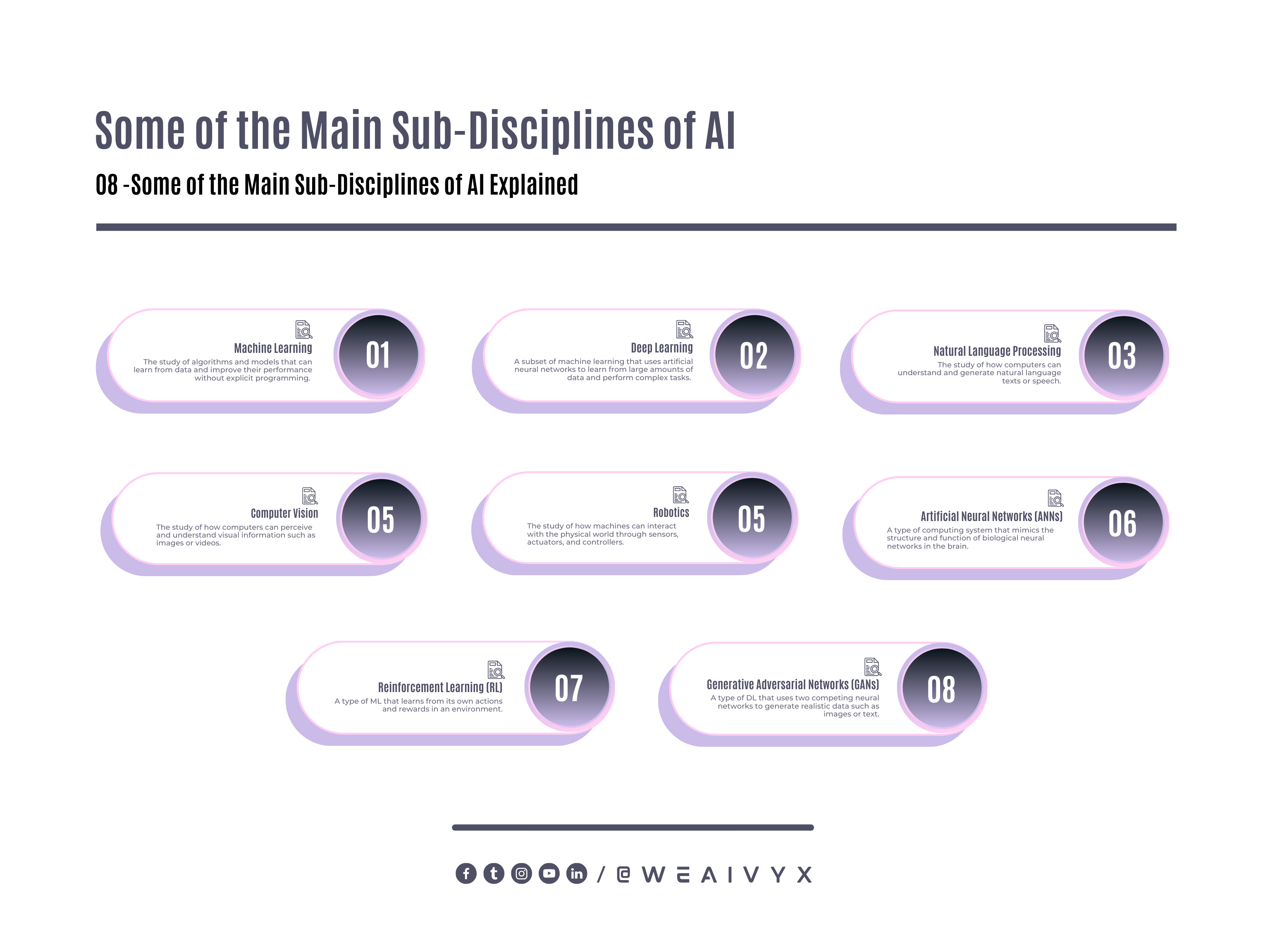
AI has many applications and use cases in various domains and industries. Some examples of AI in action are:
Self-Driving Cars: Vehicles that can navigate autonomously on roads using sensors, cameras, maps, and algorithms.
Facial Recognition: Systems that can identify or verify a person’s identity based on their face image or video.
Chatbots: Programs that can converse with humans using natural language text or speech.
Recommendation Systems: Systems that can suggest relevant products, services, or content to users based on their preferences or behavior.
Speech Recognition: Systems that can transcribe spoken words into text or commands.
Image Captioning: Systems that can generate natural language descriptions for images or videos.
Machine Translation: Systems that can translate text or speech from one language to another.
Sentiment Analysis: Systems that can detect the emotions or opinions expressed in text or speech.
Fraud Detection: Systems that can identify fraudulent transactions or activities using data analysis and pattern recognition.
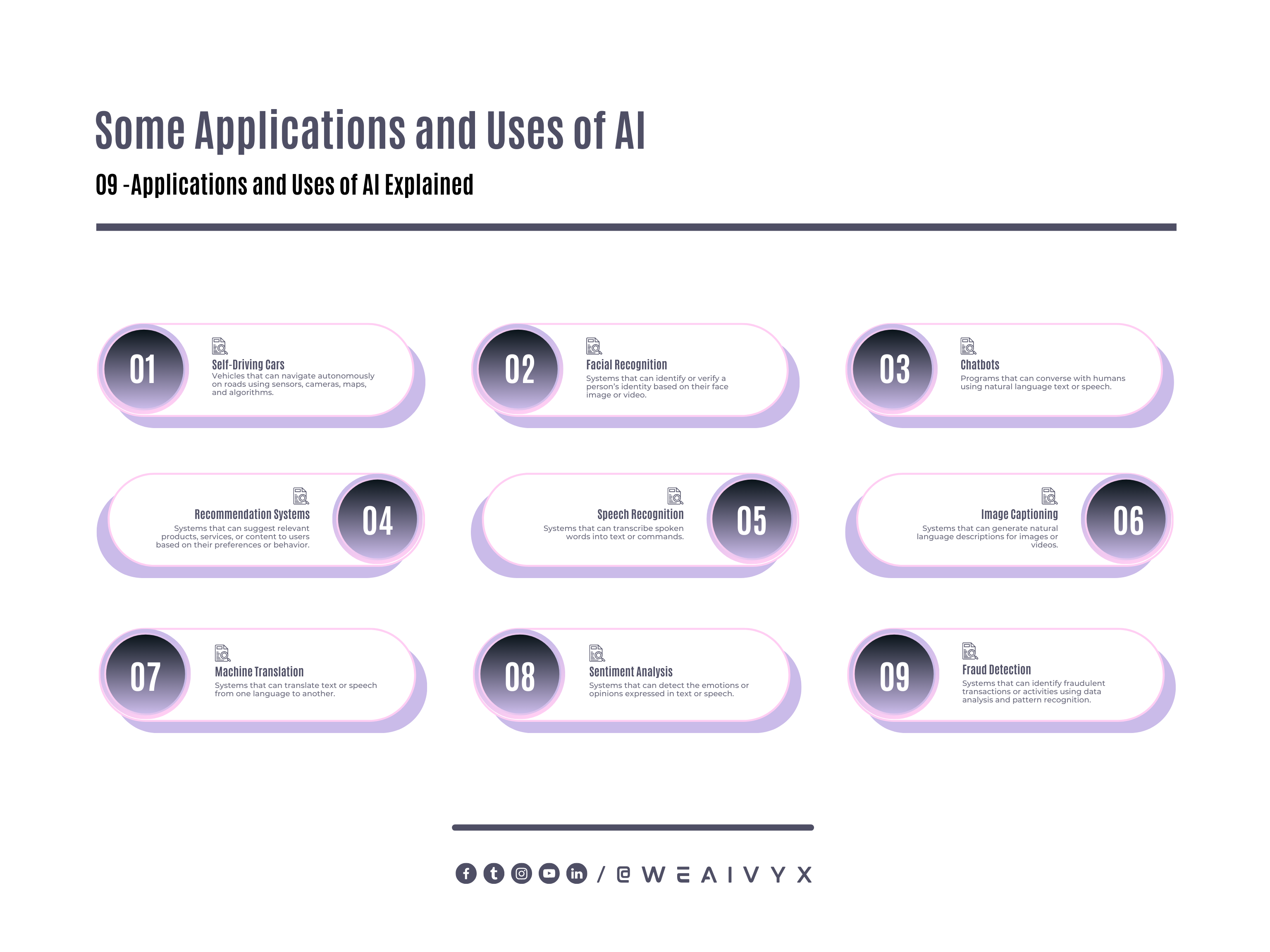
AI is a fascinating and rewarding field to learn because it:
Enables you to solve real-world problems with innovative solutions
Expand your knowledge and skills in various domains
Opens up new career opportunities and paths
Challenges you to think creatively and critically
Connects you with a global community of learners and experts
What Are the Prerequisites and Fundamentals of AI?
Before you dive into learning AI, you need to have some basic knowledge and skills in the following areas:
Mathematics
You need to understand some concepts such as linear algebra, calculus, statistics, probability, logic, optimization, etc.
These are essential for understanding how AI algorithms work and how to apply them effectively.
Programming
You need to know how to code in at least one programming language such as Python, R, Java, C++, etc.
These are the tools for implementing and testing AI solutions. Python is the most popular and widely used language for AI, as it has many libraries and frameworks that support AI development, such as TensorFlow, PyTorch, Scikit-learn, Keras, etc.
Data
You need to know how to collect, process, analyze, and visualize data using tools such as Excel, SQL, pandas, mat plotlib, etc.
Data is the fuel for AI, as it provides the information and patterns that AI systems can learn from and use to make predictions or decisions.
These are the core prerequisites and fundamentals of AI that you should master before moving on to more advanced topics.
You don’t need to be an expert in these areas, but you should have a solid foundation and a willingness to learn more as you progress.
What Are the Main Branches and Applications of AI?
As we mentioned earlier, AI is a broad field that encompasses many subfields, methods, techniques, and applications.
In this section, we will briefly introduce some of the main branches and applications of AI that you can explore and learn more about.
Machine Learning
Machine learning is the study of algorithms and models that can learn from data without explicit programming.
Machine learning is the core of AI, as it enables machines to perform tasks that are too complex or tedious for humans to code manually.
Machine learning can be divided into three main types:
Supervised Learning
The machine learns from labeled data, which means that each input has a corresponding output or target. The machine’s goal is to learn a function that can map inputs to outputs accurately.
Examples of supervised learning tasks are classification (e.g., spam detection), regression (e.g., house price prediction), and ranking (e.g., web search).
Unsupervised learning
The machine learns from unlabeled data, which means that there is no output or target for each input. The machine’s goal is to discover hidden patterns or structures in the data.
Examples of unsupervised learning tasks are clustering (e.g., customer segmentation), dimensionality reduction (e.g., PCA), and anomaly detection (e.g., fraud detection).
Reinforcement Learning
The machine learns from its actions and rewards in an environment. The machine’s goal is to learn a policy that can maximize its long-term reward.
Examples of reinforcement learning tasks are game playing (e.g., AlphaGo), robot control (e.g., self-driving cars), and recommendation systems (e.g., Netflix).
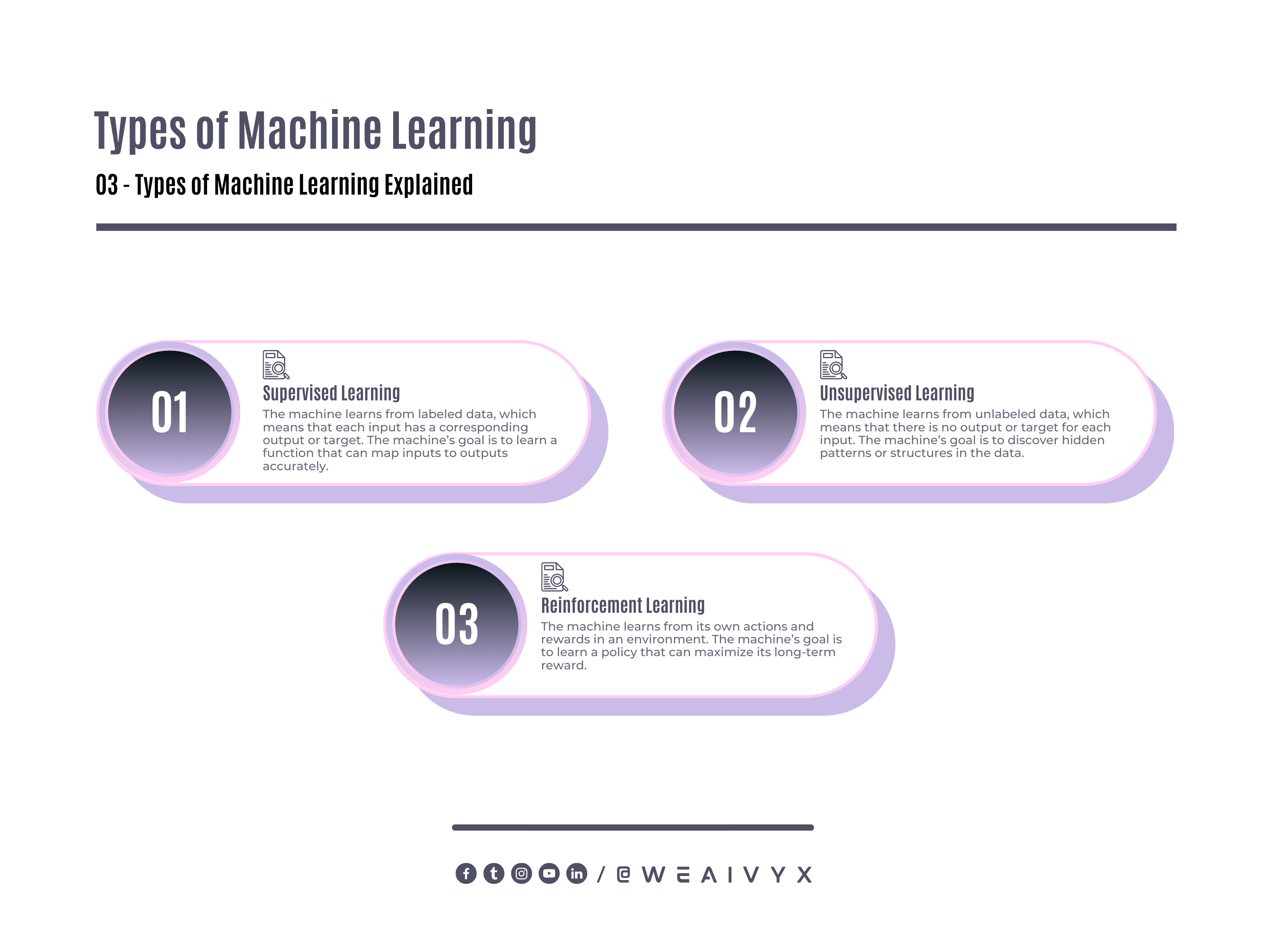
Machine learning is a vast and diverse field that has many subfields, methods, techniques, and applications.
Some of the most popular and important ones are:
Linear Models
These are simple but powerful models that use linear functions to represent the relationship between inputs and outputs. Examples of linear models are linear regression, logistic regression, SVMs, etc.
Decision Trees
These are models that use a tree-like structure to represent the decision rules for inputs and outputs. Examples of decision tree models are ID3, C4.5, CART, etc.
Neural Networks
These are models that use artificial neurons to represent complex nonlinear functions between inputs and outputs. Examples of neural network models are MLPs, CNNs, RNNs, GANs, etc.
Ensemble Methods
These are methods that combine multiple models to improve the performance or robustness of the final model. Examples of ensemble methods are bagging, boosting, stacking, etc.
Bayesian Methods
These are methods that use probability theory and Bayes’ theorem to represent uncertainty and inference in machine learning. Examples of Bayesian methods are Naive Bayes, Bayesian networks, MCMC, etc.
Machine learning is a very active and dynamic field that is constantly evolving and expanding with new research and developments.
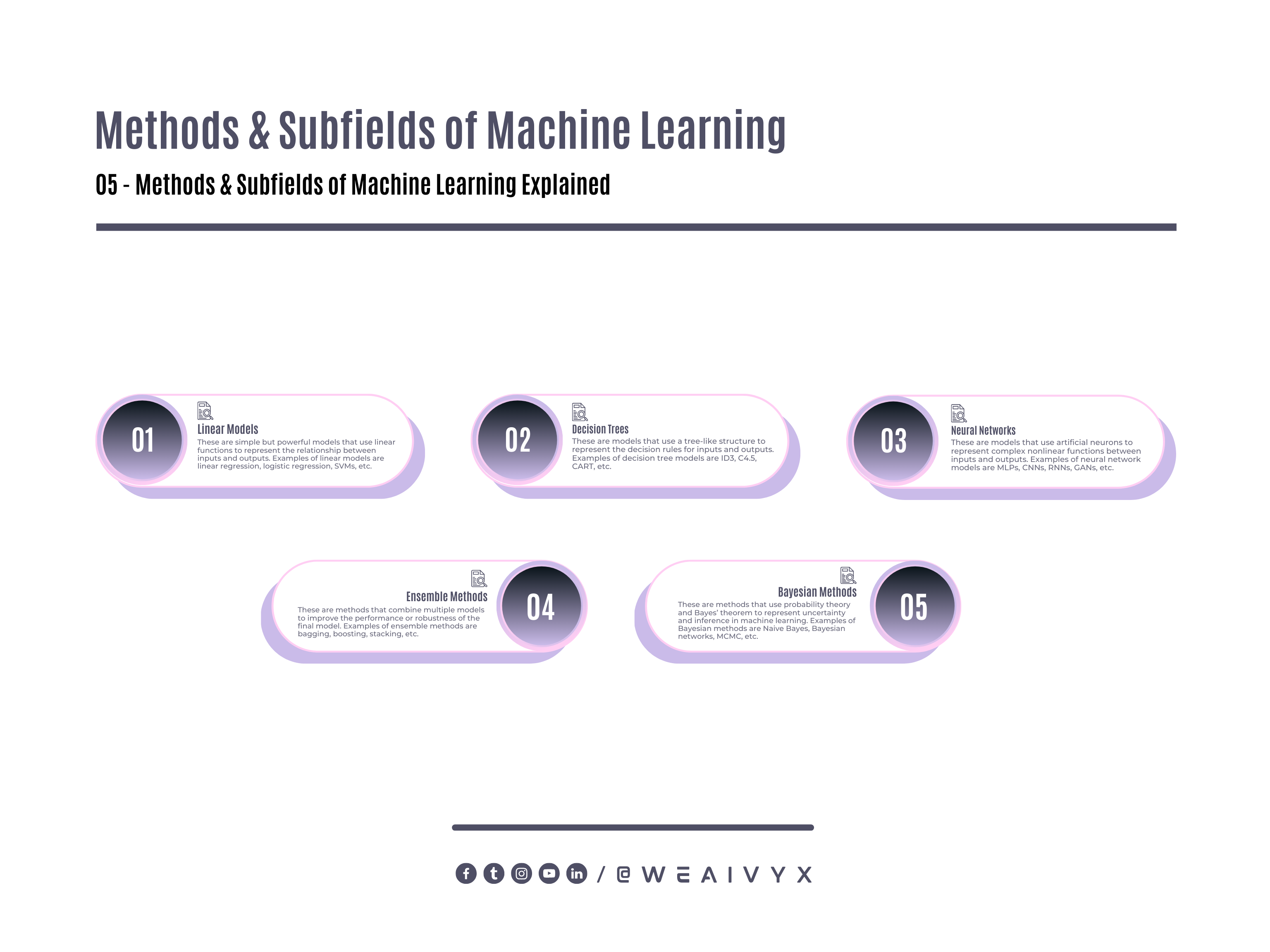
To keep up with the latest trends and innovations in machine learning, you can follow some of the top journals and conferences in this field, such as:
Journal of Machine Learning Research (JMLR)
IEEE Transactions on Pattern Analysis and Machine Intelligence (TPAMI)
Neural Information Processing Systems (NeurIPS)
International Conference on Machine Learning (ICML)
Association for the Advancement of Artificial Intelligence (AAAI)
Natural Language Processing
Natural language processing is the study of how computers can understand and generate natural language texts and speech.
Natural language processing is one of the most challenging and fascinating subfields of AI, as it involves dealing with the complexity and ambiguity of human language.
Natural language processing can be divided into two main types:
Natural Language Understanding (NLU)
The machine’s goal is to extract meaning or information from natural language texts or speech. Examples of NLU tasks are:
Sentiment analysis (e.g., detecting emotions or opinions in text or speech)
Named entity recognition (e.g., identifying people or places in text or speech)
Question answering (e.g., answering queries based on text or speech)
Summarization (e.g., generating concise summaries of text or speech)
Natural Language Generation (NLG)
The machine’s goal is to produce natural language texts or speech from some input or context. Examples of NLG tasks are:
Sentiment analysis (e.g., detecting emotions or opinions in text or speech)
Text generation (e.g., creating natural language texts from keywords or topics)
Speech synthesis (e.g., converting text to speech)
Machine translation (e.g., translating text or speech from one language to another)
Paraphrasing (e.g., rephrasing text or speech in different words), etc.

Natural language processing is a rich and diverse field that has many subfields, methods, techniques, and applications.
Some of the most popular and important ones are:
Tokenization
This is the process of breaking down natural language texts into smaller units called tokens, such as words, punctuation marks, numbers, etc.
Tokenization is the first step in most NLP tasks, as it prepares the texts for further analysis and processing.
Stemming and Lemmatization
These are processes of reducing words to their base forms or roots, such as “running” to “run” or “better” to “good”.
Stemming and lemmatization are useful for normalizing texts and reducing vocabulary size.
Part-of-Speech Tagging
This is the process of assigning grammatical categories or labels to tokens, such as nouns, verbs, adjectives, etc.
Part-of-speech tagging is useful for understanding the syntactic structure and function of texts.
Parsing
This is the process of analyzing the syntactic structure and hierarchy of texts, such as phrases, clauses, sentences, etc. Parsing is useful for extracting information and meaning from texts.
Word Embeddings
These are numerical representations of words that capture their semantic and syntactic similarities and relationships.
Word embeddings are useful for measuring word similarity and analogy, and for feeding words into neural networks.
Language Models
These are probabilistic models that estimate the likelihood of a word or a sequence of words in a given context.
Language models are useful for generating natural language texts and for improving the performance of other NLP tasks.
Attention Mechanisms
These are techniques that allow neural networks to focus on the most relevant parts of the input or output in a given context.
Attention mechanisms are useful for improving the quality and efficiency of natural language generation and understanding.
Transformers
These are neural network architectures that use attention mechanisms to encode and decode natural language inputs and outputs.
Transformers are useful for achieving state-of-the-art results in various NLP tasks, such as machine translation, text summarization, text generation, etc.
Natural language processing is a very active and dynamic field that is constantly evolving and expanding with new research and developments.
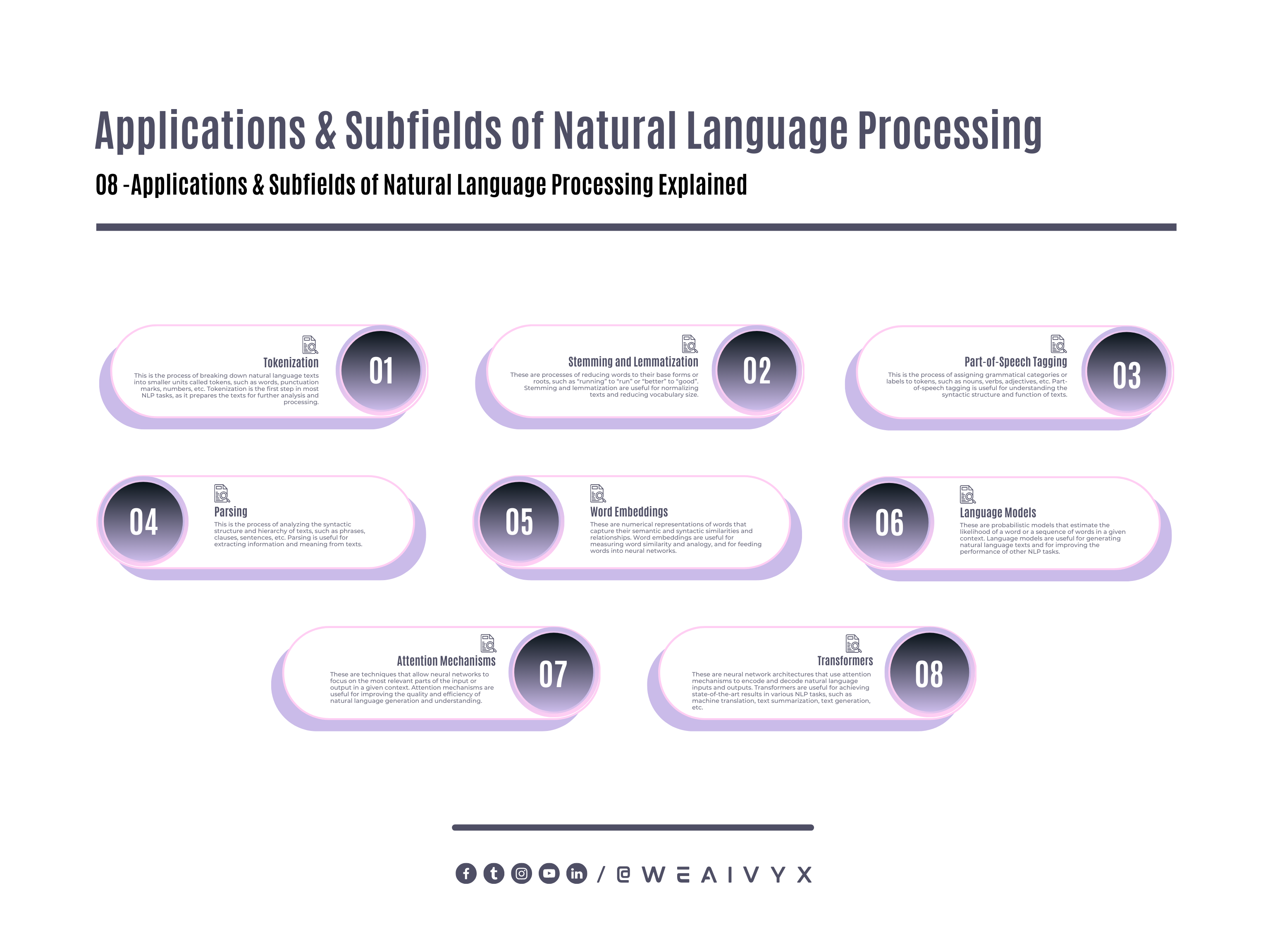
To keep up with the latest trends and innovations in natural language processing, you can follow some of the top journals and conferences in this field, such as:
Computational Linguistics (CL)
Natural Language Engineering (NLE)
Transactions of the Association for Computational Linguistics (TACL)
Annual Meeting of the Association for Computational Linguistics (ACL)
Conference on Empirical Methods in Natural Language Processing (EMNLP)
Conference on Neural Information Processing Systems (NeurIPS)
Computer Vision
Computer vision is the study of how computers can perceive and understand visual information such as images and videos.
Computer vision is one of the most exciting and impactful subfields of AI, as it enables machines to see and interact with the world.
Computer vision can be divided into some main types:
1. Image Processing & Analysis
The machine’s goal is to enhance, transform, or manipulate images using various operations such as filtering, cropping, resizing, rotating, etc. Image processing is useful for improving the quality and usability of images.
2. Edge Detection
This is the process of identifying the boundaries or contours of objects in images. Edge detection is useful for simplifying images and highlighting important features.
3. Segmentation
This is the process of dividing images into regions or segments that have similar characteristics or belong to the same object.
Segmentation is useful for separating foreground from background and identifying individual objects in images.
4. Feature Extraction
This is the process of extracting distinctive or salient features from images that can be used for further analysis or processing.
Feature extraction is useful for reducing image dimensionality and representing image content.
5. Object Detection
This is the process of locating and bounding objects in images using rectangular boxes or other shapes.
Object detection is useful for identifying what objects are present in images and where they are located.
6. Object Recognition
This is the process of identifying and labeling objects in images using predefined classes or categories.
Object recognition is useful for understanding what objects are in images and what categories they belong to.
7. Face Detection and Recognition
These are processes of locating and identifying faces in images using facial features or landmarks.
Face detection and recognition are useful for verifying or recognizing people’s identities or emotions in images.
8. Optical Character Recognition (OCR)
This is the process of converting text in images to digital text that can be edited or processed. OCR is useful for extracting information from documents, signs, books, etc.
9. Scene Understanding
This is the process of analyzing the whole scene in images, such as the objects, actions, events, relationships, etc.
Scene understanding is useful for generating natural language descriptions or captions for images.
10. Image Synthesis
This is the process of creating new images from existing images or scratch using various techniques such as blending, stitching, inpainting, super-resolution, etc. Image synthesis is useful for enhancing, restoring, or generating realistic or artistic images.
Computer vision is a very active and dynamic field that is constantly evolving and expanding with new research and developments.
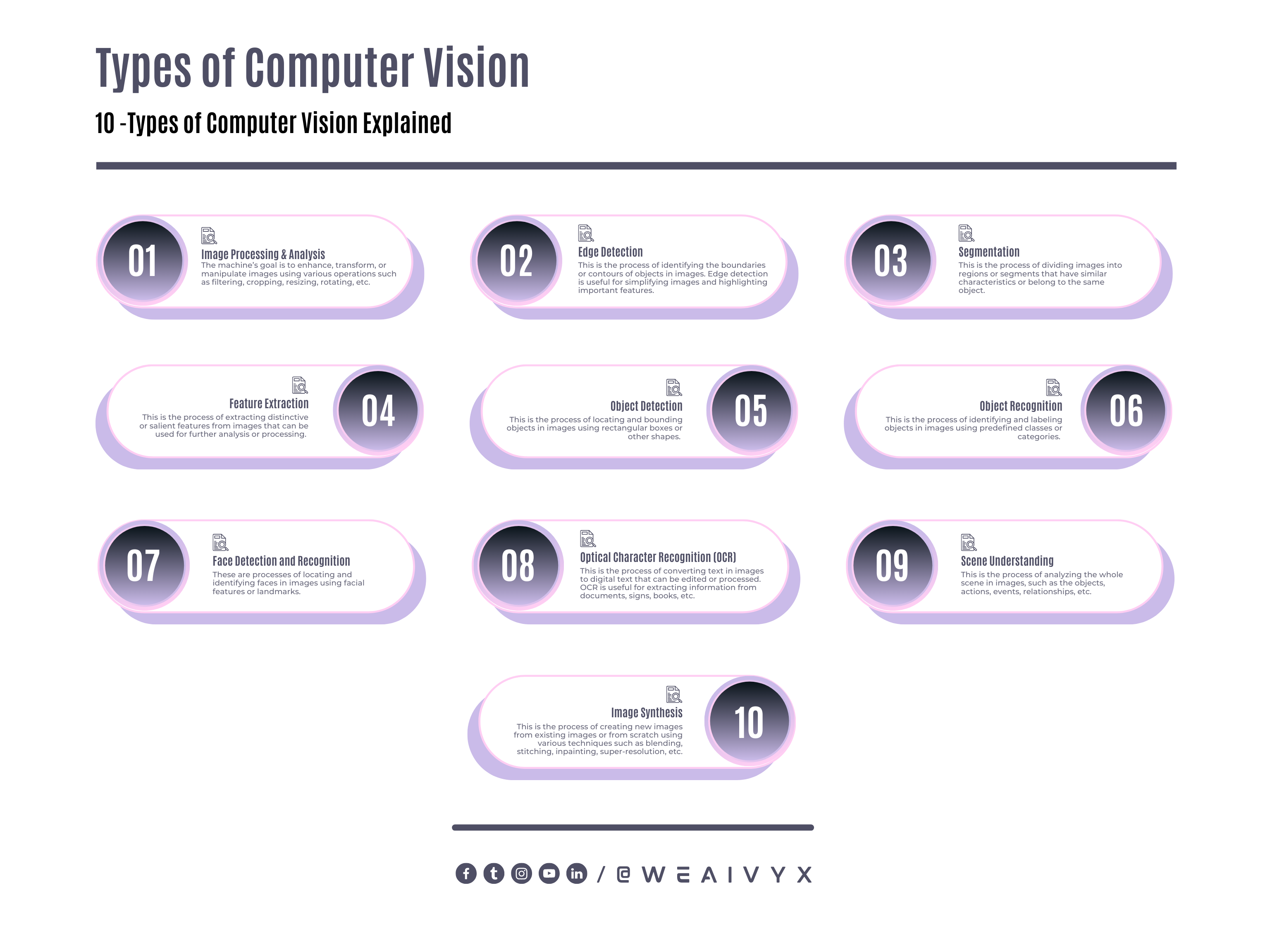
To keep up with the latest trends and innovations in computer vision, you can follow some of the top journals and conferences in this field, such as:
IEEE Transactions on Image Processing (TIP)
IEEE Transactions on Pattern Analysis and Machine Intelligence (TPAMI)
International Journal of Computer Vision (IJCV)
Computer Vision and Image Understanding (CVIU)
International Conference on Computer Vision (ICCV)
European Conference on Computer Vision (ECCV)
Conference on Computer Vision and Pattern Recognition (CVPR)
Robotics
Robotics is the study of how machines can interact with the physical world through sensors, actuators, and controllers.
Robotics is one of the most interdisciplinary and applied subfields of AI, as it involves designing, building, programming, and testing machines that can perform various tasks.
Robotics can be divided into two main types:
Industrial Robotics
The machine’s goal is to perform specific tasks in a controlled environment, such as manufacturing, assembly, welding, painting, etc.
Industrial robotics is useful for increasing productivity, quality, and safety in various industries.
Service Robotics
The machine’s goal is to perform general tasks in an uncontrolled environment, such as navigation, exploration, manipulation, communication, etc.
Service robotics is useful for providing assistance, entertainment, education, or social interaction to humans or animals.
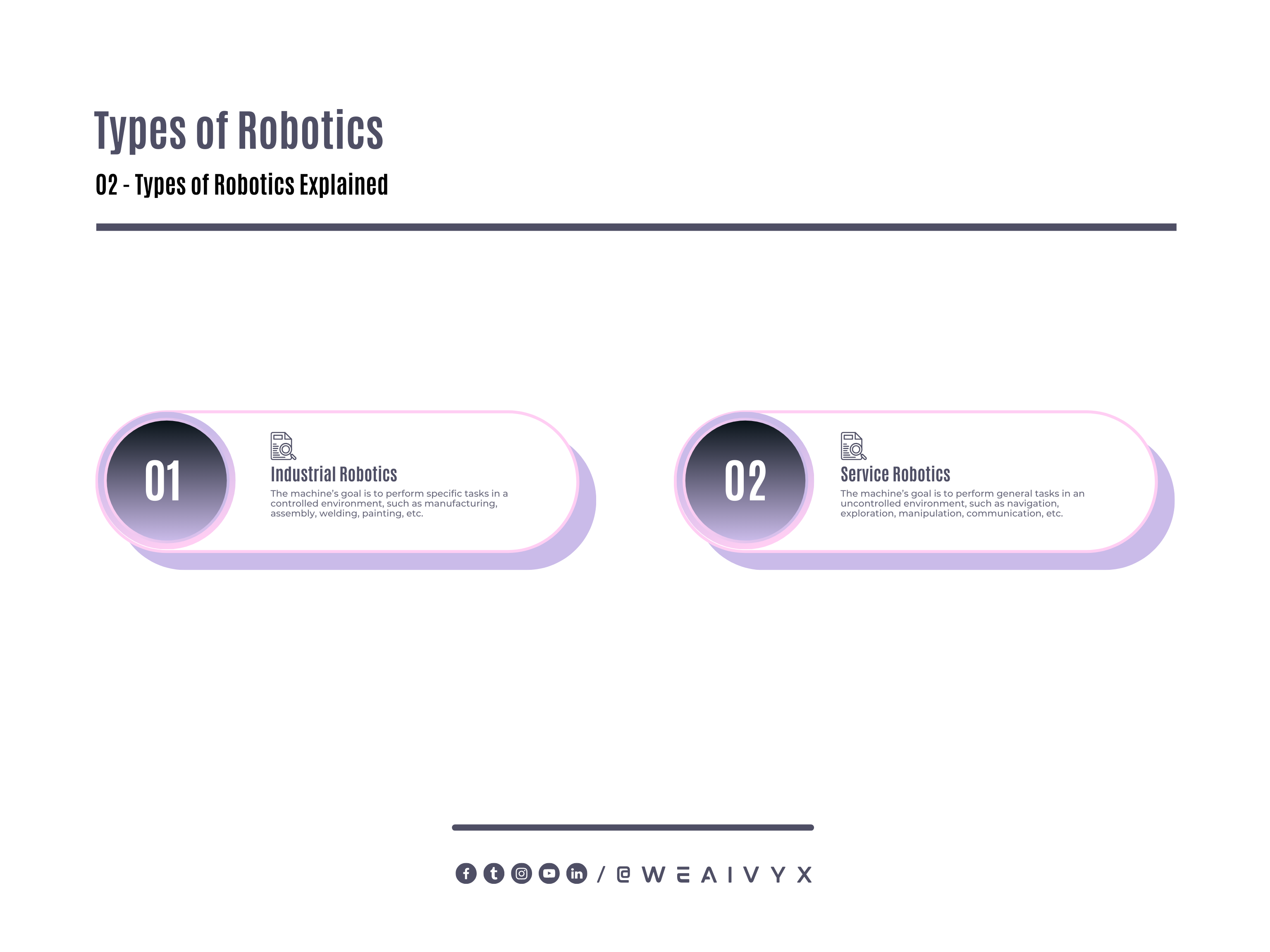
Robotics is a complex and diverse field that has many subfields, methods, techniques, and applications.
Some of the most popular and important ones are:
Kinematics
This is the study of the geometry and motion of robots and their parts. Kinematics is useful for modeling and controlling the position, orientation, velocity, and acceleration of robots.
Dynamics
This is the study of the forces and torques that affect the motion of robots and their parts.
Dynamics is useful for modeling and controlling the energy, momentum, and stability of robots.
Control
This is the study of how to design and implement algorithms that can regulate the behavior of robots according to some objectives or constraints. Control is useful for achieving the desired performance or functionality of robots.
Perception
This is the study of how robots can acquire and process information from their sensors, such as cameras, microphones, lidars, radars, etc.
Perception is useful for enabling robots to sense and understand their environment and themselves.
Cognition
This is the study of how robots can reason, learn, plan, and make decisions based on their perception and knowledge.
Cognition is useful for enabling robots to adapt and improve their behavior and performance over time.
Interaction
This is the study of how robots can communicate and cooperate with other robots or humans using various modalities such as speech, gestures, facial expressions, etc.
Interaction is useful for enabling robots to achieve common goals or provide social benefits.
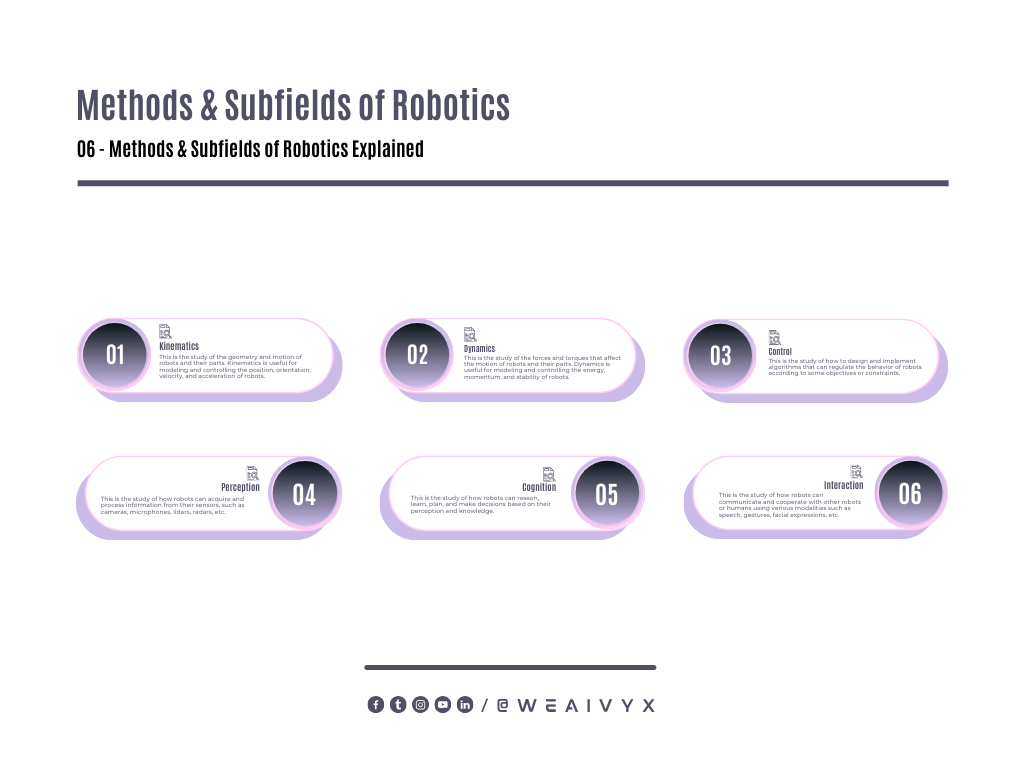
Robotics is a very active and dynamic field that is constantly evolving and expanding with new research and developments.
To keep up with the latest trends and innovations in robotics, you can follow some of the top journals and conferences in this field, such as:
IEEE Transactions on Robotics (T-RO)
International Journal of Robotics Research (IJRR)
Robotics and Autonomous Systems (RAS)
IEEE Robotics and Automation Letters (RA-L)
International Conference on Robotics and Automation (ICRA)
International Conference on Intelligent Robots and Systems (IROS)
Robotics: Science and Systems (RSS)
How Can You Learn AI Through Online Courses, Books, Blogs, Podcasts, and Projects?
Now that you have an overview of what AI is and what are some of the main branches and applications of AI, you may be wondering how can you learn AI from scratch.
Fortunately, some many online resources and platforms can help you learn AI at your own pace and level.
In this section, we will recommend some of the best online courses, books, blogs, podcasts, and projects that can help you learn AI in 2023.
These resources are not exhaustive or definitive, but rather a selection of some of the most popular and reputable ones that we think are worth checking out.
Online Courses
Online courses are one of the most convenient and effective ways to learn AI from scratch. Online courses offer structured and interactive learning experiences that can teach you the theory and practice of AI comprehensively and engagingly.
Many online platforms offer online courses on AI, such as Coursera, Udemy, edX, Udacity, etc.
These platforms have courses for different levels, topics, durations, prices, etc. You can choose the courses that suit your needs and preferences.
Some of the best online courses on AI that we recommend are:
Introduction to Artificial Intelligence by IBM (Coursera)
This course will give you a general introduction to AI, its history, applications, ethics, etc. You will also learn some basic concepts and tools for AI development using Python.
Machine Learning by Stanford University (Coursera)
This course will teach you the fundamentals of machine learning, such as linear regression, logistic regression, neural networks, SVMs, etc. You will also learn how to apply machine learning to various domains using MATLAB or Octave.
Deep Learning Specialization by deeplearning.ai (Coursera)
This specialization will teach you the foundations and applications of deep learning, such as ANNs, CNNs, RNNs, GANs, etc. You will also learn how to use TensorFlow and Keras to build and train deep-learning models.
Natural Language Processing Specialization by deeplearning.ai (Coursera)
This specialization will teach you the fundamentals and applications of natural language processing, such as tokenization, embedding, sentiment analysis, machine translation, text generation, etc.
You will also learn how to use TensorFlow and PyTorch to build and train natural language processing models.
Computer Vision Nanodegree by Udacity
This nano degree will teach you the fundamentals and applications of computer vision, such as image processing, feature extraction, object detection, face recognition, image synthesis, etc.
You will also learn how to use OpenCV, TensorFlow, and PyTorch to build and train computer vision models.
Robotics Software Engineer Nanodegree by Udacity
This nano degree will teach you the fundamentals and applications of robotics, such as kinematics, dynamics, control, perception, cognition, interaction, etc. You will also learn how to use ROS, Gazebo, and MoveIt to design and program robots.
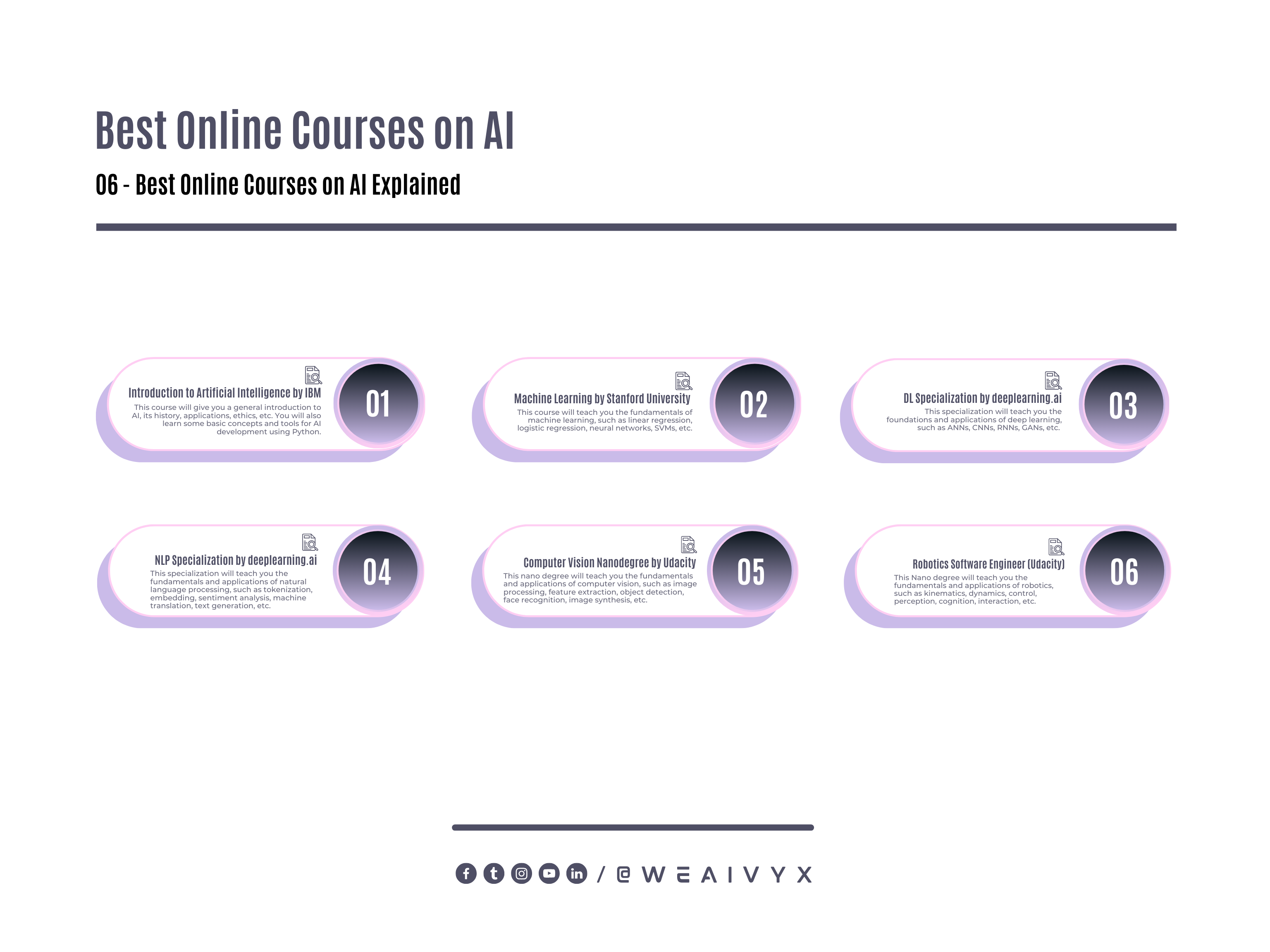
These are some of the online courses that we think are worth taking if you want to learn AI from scratch in 2023.
Of course, there are many other online courses that you can find and explore on your own. The key is to choose the courses that match your level, interest, and goal.
Books
Books are another great way to learn AI from scratch. Books can provide you with in-depth and comprehensive knowledge and insights on AI that online courses may not cover.
Books can also serve as references or guides that you can consult anytime you need.
There are many books on AI that you can read and learn from, such as textbooks, manuals, tutorials, etc. You can choose the books that suit your needs and preferences.
Some of the best books on AI that we recommend are:
1. Artificial Intelligence
A Modern Approach by Stuart Russell and Peter Norvig: This book is considered the classic and definitive textbook on AI.
It covers the history, concepts, methods, techniques, and applications of AI clearly and rigorously.
It also includes exercises and projects that can help you practice and apply what you learn.
2. Hands-on Machine Learning with Scikit-Learn, Keras, and TensorFlow by Aurélien Géron
This book is a practical and comprehensive guide to machine learning and deep learning using Python.
It covers the theory and practice of machine learning and deep learning using Scikit-learn, Keras, and TensorFlow.
It also includes examples and projects that can help you build and train machine learning and deep learning models.
3. Natural Language Processing with Python by Steven Bird, Ewan Klein, and Edward Loper
This book is an introduction and tutorial on natural language processing using Python. It covers the basics and applications of natural language processing using NLTK (Natural Language Toolkit), a popular Python library for natural language processing.
It also includes exercises and projects that can help you analyze and process natural language texts.
4. Computer Vision, Algorithms and Applications by Richard Szeliski
This book is a comprehensive and accessible introduction to computer vision. It covers the theory and practice of computer vision using various algorithms and applications.
It also includes exercises and projects that can help you implement and test computer vision solutions.
5. Probabilistic Robotics by Sebastian Thrun, Wolfram Burgard, and Dieter Fox
This book is a detailed and authoritative introduction to probabilistic robotics. It covers the theory and practice of robotics using probabilistic methods and techniques.
It also includes exercises and projects that can help you design and program probabilistic robots.

These are some of the books that we think are worth reading if you want to learn AI from scratch in 2023.
Of course, there are many other books that you can find and explore on your own. The key is to choose the books that match your level, interest, and goal.
Blogs
Blogs are another great way to learn AI from scratch. Blogs can provide you with up-to-date and relevant information and insights on AI that books or courses may not cover.
Blogs can also serve as sources of inspiration or motivation that can help you learn and grow.
There are many blogs on AI that you can follow and read, such as personal blogs, company blogs, academic blogs, etc. You can choose the blogs that suit your needs and preferences.
Some of the best blogs on AI that we recommend are:
1. Machine Learning Mastery by Jason Brownlee
This blog is a practical and comprehensive resource on machine learning and deep learning using Python. It covers the theory and practice of machine learning and deep learning using various tutorials, guides, tips, tricks, etc.
2. Towards Data Science by Medium
This blog is a platform for sharing and learning about data science, machine learning, deep learning, natural language processing, computer vision, etc. It features articles, stories, projects, etc. from various authors and experts in the field.
3. The Gradient by The Gradient
This blog is an online magazine for research and perspectives on artificial intelligence. It features articles, reviews, interviews, etc. from various researchers and practitioners in the field.
4. OpenAI Blog by OpenAI
This blog is a platform for sharing and learning about the research and projects of OpenAI, a research organization dedicated to creating and ensuring the safe and beneficial use of artificial intelligence. It features articles, videos, podcasts, etc. from various researchers and engineers at OpenAI.
5. Google AI Blog by Google
This blog is a platform for sharing and learning about the research and projects of Google AI, a division of Google that focuses on artificial intelligence. It features articles, videos, podcasts, etc. from various researchers and engineers at Google AI.
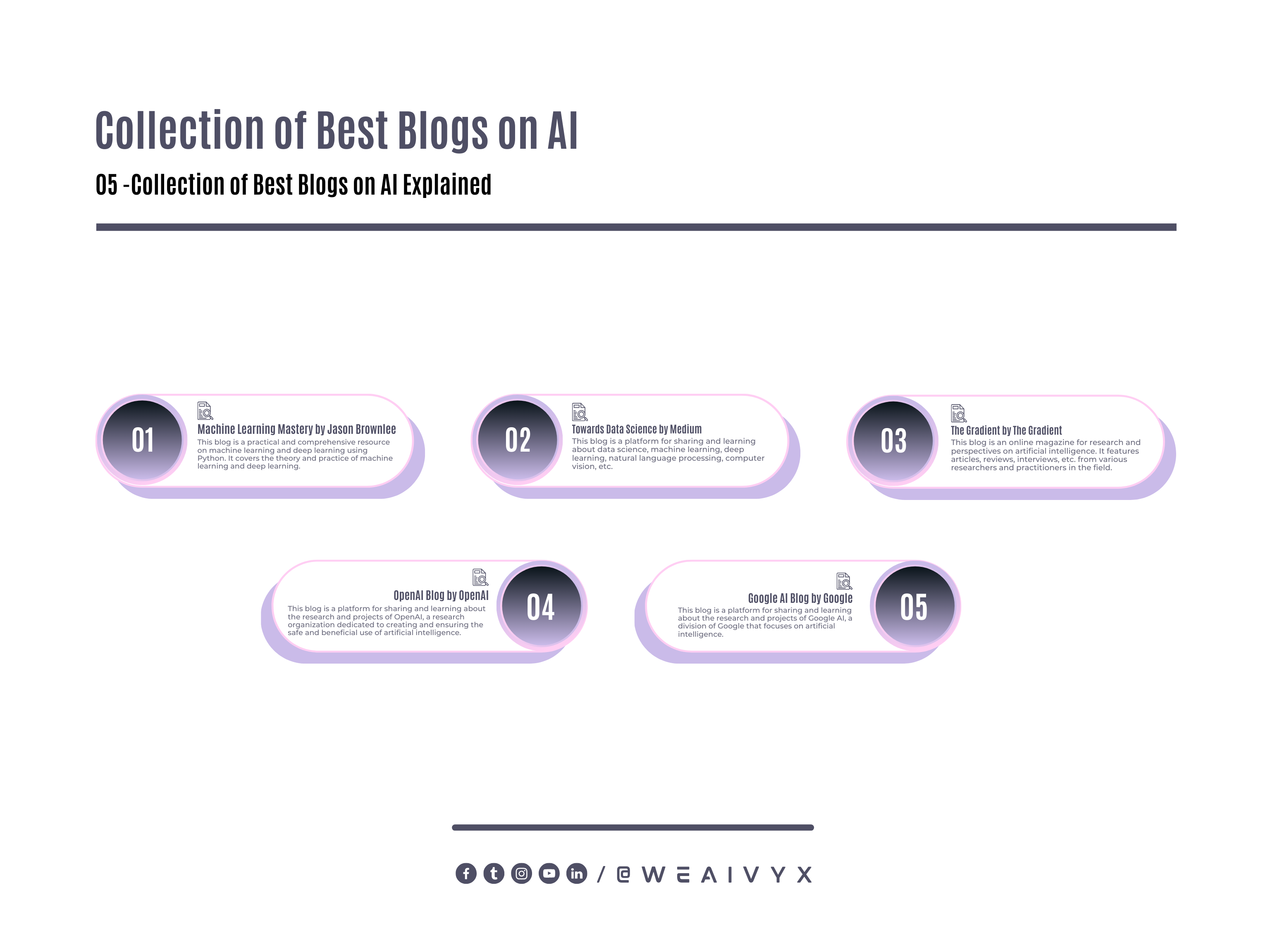
These are some of the blogs that we think are worth following if you want to learn AI from scratch in 2023.
Of course, there are many other blogs that you can find and explore on your own. The key is to choose the blogs that match your level, interest, and goal.
Podcasts
Podcasts are another great way to learn AI from scratch. Podcasts can provide you with audio content that can teach you the theory and practice of AI conveniently and engagingly.
Podcasts can also serve as sources of entertainment or education that can help you learn and grow.
There are many podcasts on AI that you can listen to and learn from, such as interviews, discussions, lectures, etc. You can choose the podcasts that suit your needs and preferences.
Some of the best podcasts on AI that we recommend are:
1. Lex Fridman Podcast by Lex Fridman
This podcast is a series of conversations with various guests on topics such as artificial intelligence, deep learning, natural language processing, computer vision, robotics, etc.
The podcast features guests such as Elon Musk, Jack Dorsey, Eric Schmidt, etc.
2. Machine Learning Guide by OCDevel
This podcast is a series of episodes that teach the fundamentals and applications of machine learning and deep learning using various examples, analogies, tips, etc.
The podcast covers topics such as linear regression, logistic regression, neural networks, SVMs, etc.
3. Data Skeptic by Kyle Polich
This podcast is a series of episodes that explore the topics of data science, machine learning, artificial intelligence, statistics, etc. using various interviews, mini-episodes, tutorials, etc.
The podcast covers topics such as clustering, dimensionality reduction, natural language processing, computer vision, etc.
4. Artificial Intelligence Podcast by MIT Technology Review
This podcast is a series of episodes that discuss the latest news and trends in artificial intelligence and its impact on society and humanity. The podcast features guests such as Andrew Ng, Yann LeCun, Fei-Fei Li, etc.
5. AI in Business by Emerj
This podcast is a series of episodes that explore the use cases and best practices of artificial intelligence in various industries and domains such as healthcare, finance, retail, marketing, etc.
The podcast features guests such as executives, managers, consultants, researchers, etc.

These are some of the podcasts that we think are worth listening to if you want to learn AI from scratch in 2023.
Of course, there are many other podcasts that you can find and explore on your own. The key is to choose the podcasts that match your level, interest, and goal.
Projects
Projects are another great way to learn AI from scratch. Projects can provide you with hands-on experience and practice that can help you apply what you learn and improve your skills and confidence.
Projects can also serve as sources of portfolio or resume that can help you showcase your work and achievements.
There are many projects on AI that you can do and learn from, such as tutorials, competitions, challenges, etc. You can choose the projects that suit your needs and preferences.
Some of the best projects on AI that we recommend are:
1. Kaggle
This is a platform for data science and machine learning competitions and challenges. You can participate in Kaggle in various competitions and challenges on topics such as image classification, natural language processing, computer vision, etc.
You can also learn from other participants’ solutions and feedback.
2. TensorFlow
This is a platform for building and training machine learning and deep learning models using Python.
You can use TensorFlow to create various projects on topics such as image recognition, text generation, speech recognition, etc.
You can also learn from various tutorials, guides, examples, etc. that TensorFlow provides.
3. PyTorch
This is a platform for building and training machine learning and deep learning models using Python.
You can use PyTorch to create various projects on topics such as natural language processing, computer vision, generative adversarial networks, etc. You can also learn from various tutorials, guides, examples, etc. that PyTorch provides.
4. OpenAI
This is a platform for creating and exploring artificial intelligence and its impact on society and humanity.
You can use OpenAI to create various projects on topics such as reinforcement learning, natural language processing, computer vision, etc.
You can also learn from various research papers, blogs, videos, podcasts, etc. that OpenAI publishes.
5. ROS
This is a platform for developing and programming robots using various languages and tools. You can use ROS to create various projects on topics such as robot control, perception, cognition, interaction, etc. You can also learn from various tutorials, guides, examples, etc. that ROS provides.
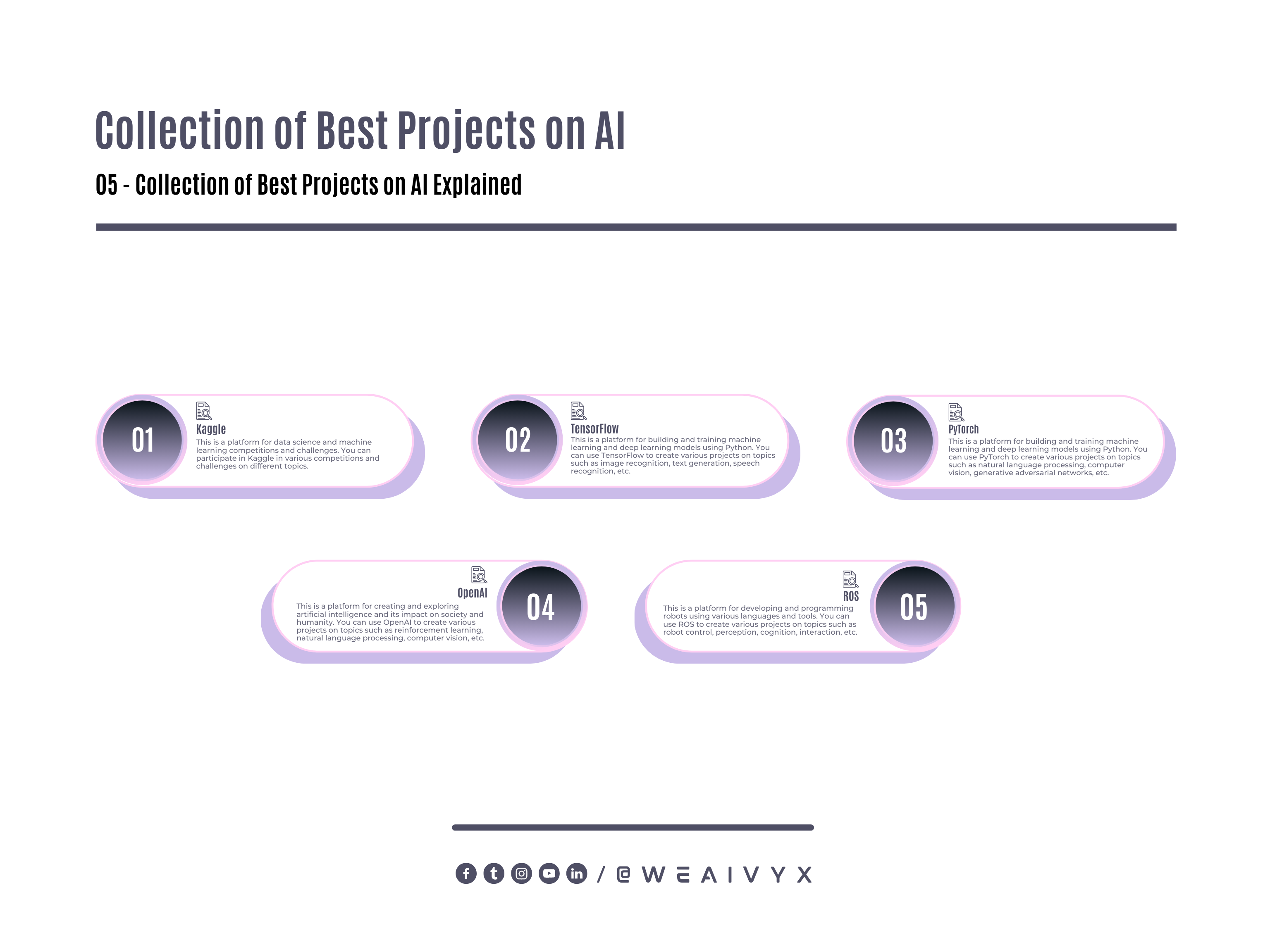
These are some of the projects that we think are worth doing if you want to learn AI from scratch in 2023.
Of course, there are many other projects that you can find and explore on your own. The key is to choose the projects that match your level, interest, and goal.
How Can You Advance Your AI Career and Join the AI Community?
Learning AI from scratch is not only a personal endeavor but also a professional one. AI is a highly sought-after and competitive field that offers many career opportunities and paths for those who have the skills and passion for it.
If you want to advance your AI career and join the AI community, you need to do more than just learn AI from online resources and platforms. You need to also:
Build Your Portfolio or Resume
You need to showcase your work and achievements in AI by creating a portfolio or resume that highlights your skills, projects, education, experience, etc.
You can use platforms such as GitHub, LinkedIn, Medium, etc. to create and share your portfolio or resume online.
Network With Other AI Enthusiasts or Professionals
You need to connect with other people who share your interest or expertise in AI by attending or participating in various events or activities such as meetups, workshops, hackathons, webinars, etc.
You can use platforms such as Meetup, Eventbrite, Hackathon.com, etc. to find and join AI-related events or activities near you or online.
Learn From Other AI Experts or Mentors
You need to learn from other people who have more experience or knowledge in AI by following or reaching out to them online or offline.
You can use platforms such as Twitter, YouTube, Quora, Reddit, etc. to follow and learn from AI experts or mentors.
You can also use platforms such as MentorCruise, Mentorship.ai, etc. to find and connect with AI mentors who can guide and support you in your AI journey.
Contribute to the AI Community or Society
You need to contribute to the AI community or society by sharing your work, ideas, insights, feedback, etc. with others online or offline.
You can use platforms such as Medium, GitHub, Kaggle, Stack Overflow, etc. to share and showcase your work, ideas, insights, feedback, etc. with the AI community.
You can also use platforms such as OpenAI, Kaggle, DataKind, etc. to contribute to AI projects or initiatives that have a social or humanitarian impact.

These are some of the ways that you can advance your AI career and join the AI community in 2023.
Of course, there are many other ways that you can find and explore on your own. The key is to be proactive, curious, and passionate about learning and growing in AI.
Conclusion
In this guide, we have given you a complete overview of how to learn AI from scratch in 2023. We have covered the following topics:
What is AI and why should you learn it?
What are the prerequisites and fundamentals of AI?
What are the main branches and applications of AI?
How can you learn AI through online courses, books, blogs, podcasts, and projects?
How can you advance your AI career and join the AI community?
We hope that this guide has been helpful and informative for you. We also hope that this guide has inspired and motivated you to start or continue your AI journey.
AI is a fascinating and rewarding field that offers endless possibilities and opportunities for learning and growth.
However, AI is also a challenging and complex field that requires dedication and perseverance.
Learning AI from scratch is not easy, but it is possible and achievable. You just need to have the right mindset, attitude, and resources.
Remember that learning AI is not a destination, but a journey. A journey that is full of challenges, surprises, discoveries, and joys. A journey that is worth taking.
Thank you for reading this guide. We wish you all the best in your AI journey.
